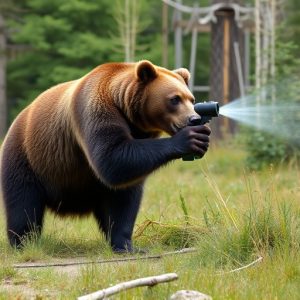Navigating Alaska’s Bear Country: Gear, Spray, and Ecosystem Impact
Bear spray, a popular defense mechanism in bear-infested areas like Alaska, disrupts bears' sen…….
Bear spray, a popular defense mechanism in bear-infested areas like Alaska, disrupts bears' senses temporarily through residue. While effective, its impact extends beyond targeted animals, affecting aquatic life and plants. Responsible usage involves targeting bears' faces and minimizing residue on gear to ensure personal safety while preserving the ecosystem. Proper preparation with gear like durable clothing, a hard hat, and face shield is crucial for safe adventures.
As you venture into Alaska’s stunning wilderness, understanding the importance of bear repellent hiking gear is paramount. This article delves into the world of bear safety, focusing on crucial aspects like bear spray residue and its impact on Alaska’s wildlife ecosystem. We’ll explore why choosing the right gear is essential for a safe and sustainable adventure. By the end, you’ll be equipped with knowledge to navigate bear country effectively while minimizing harm to the environment.
- Understanding Bear Spray and Its Efficacy: A Closer Look at Bear Spray Residue
- The Impact of Bear Repellents on Alaska's Wildlife Ecosystem
- Choosing the Right Hiking Gear: Tips for Safe and Sustainable Bear Country Adventures
Understanding Bear Spray and Its Efficacy: A Closer Look at Bear Spray Residue
Bear spray, a common deterrent for hikers and outdoor enthusiasts in bear country, has been the subject of much debate regarding its efficacy. When used properly, bear spray can be highly effective against both black bears and grizzly bears. The key lies in understanding how it works and what happens after application.
The active ingredients in bear spray create a residue that disrupts the bear’s sense of smell and vision. This residue is typically a fine mist or aerosol that can travel several meters, depending on the product and weather conditions. While bear spray is designed to deter bears from approaching, it’s important to note that the impact on wildlife is minimal when used responsibly. The residue generally evaporates quickly, leaving no lasting effects on the environment or bears once they have moved away. However, proper usage includes aiming for the face and eyes of the bear, as this area is most sensitive to the irritants. Responsible use ensures both personal safety and minimizes potential harm to the wildlife encountered during hikes in bear country.
The Impact of Bear Repellents on Alaska's Wildlife Ecosystem
In Alaska, where bears are an integral part of the ecosystem, the use of bear repellent is a double-edged sword. While it offers hikers and campers much-needed protection against potential attacks, the impact of these repellents on the local wildlife cannot be overlooked. Bear spray, a popular choice for deterring bears, leaves a residue that can affect not just the targeted animals but also other species in the ecosystem.
The presence of bear spray residue in water bodies and vegetation can have adverse effects on aquatic life and plants, disrupting the delicate balance of Alaska’s wildlife. This is particularly concerning as these repellents can lead to indirect harm, such as changes in feeding habits or habitats, impacting a wide range of animals, including non-target species. Understanding the potential consequences of bear spray residue on the state’s vibrant ecosystem is crucial for hikers and outdoor enthusiasts to make informed decisions when choosing their hiking gear.
Choosing the Right Hiking Gear: Tips for Safe and Sustainable Bear Country Adventures
When venturing into bear country, selecting the appropriate hiking gear is paramount for a safe and enjoyable adventure. A key component to consider is bear spray—a potent deterrent that can be used as a last resort when encountering a grizzly or black bear. Look for bear sprays with a high concentration of capsaicin, the active ingredient known for its effectiveness in repelling bears without causing significant wildlife impact. Ensure you understand how to properly handle and deploy the spray, as incorrect usage may not only be ineffective but could also lead to accidental harm.
In addition to bear spray, durable and protective clothing is essential. Opt for layers that can be easily added or removed depending on weather conditions. A hard hat and face shield, while unconventional for hiking, can provide an extra layer of protection against bear attacks in particularly treacherous areas. Always stay alert and make noise as you hike to avoid surprising bears; this practice helps reduce the likelihood of a defensive response from wildlife. Remember, minimizing bear spray residue on your gear by regular cleaning is crucial for both safety and environmental stewardship, ensuring that these potent deterrents are used responsibly and effectively.
When hiking in bear country, understanding the effectiveness of bear spray and choosing the right gear are essential for a safe and sustainable adventure. While bear spray can be an effective deterrent against attacks by creating a residue that repels bears, its impact on Alaska’s wildlife ecosystem must also be considered. By selecting high-quality, durable gear and adhering to best practices, hikers can minimize their footprint and coexist harmoniously with the remarkable wildlife of Alaska.


